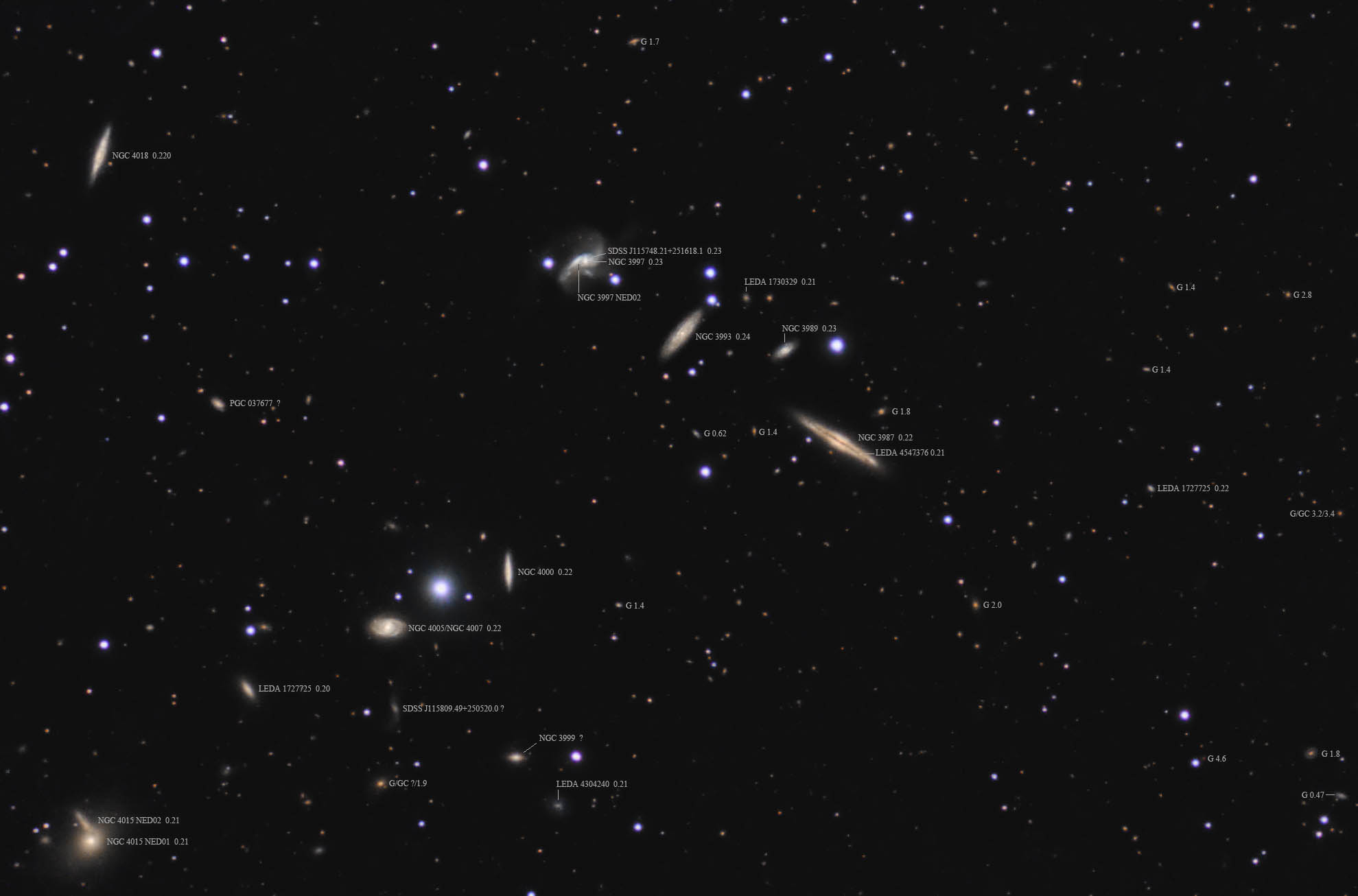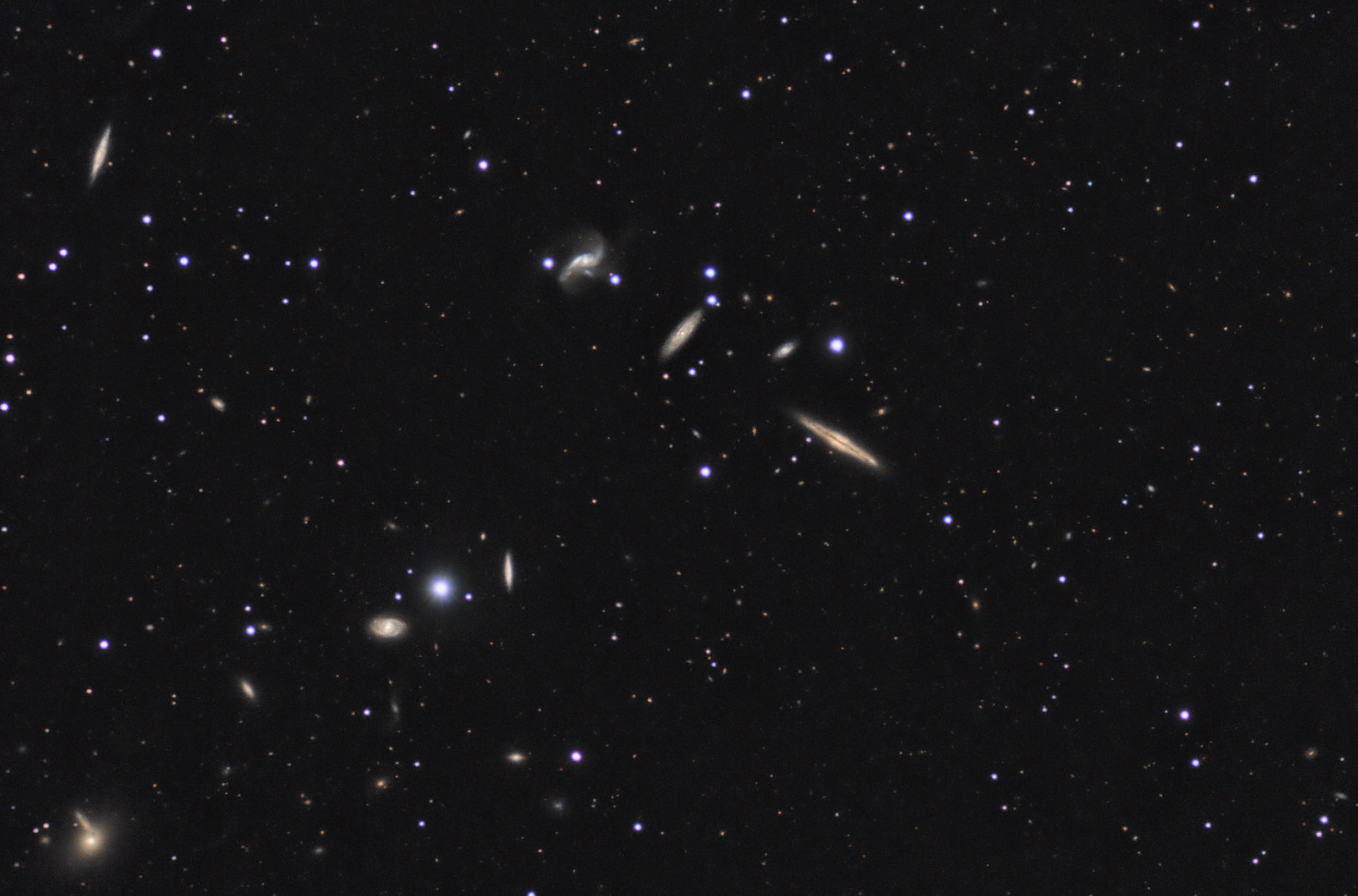Object name: NGC3997Designation(s): NGC3997, NGC3887, NGC3989, NGC3999, NGC4000, NGC4007, NGC4015, NGC4018, NGC 3997 is a galaxy that's part of a large group that goes by many names. The NGC Project uses the name NGC 4007 Group which has its own baggage I'll get to later. The group is located in Leo just over the border with Coma Berenices and lies some 220 million light-years away.
NGC 3997 is a rather confusing galaxy. Its structure is very disjointed with plumes everywhere. One arm appears could be considered a separate galaxy if the rest of NGC 3997 is masked out. The annotated image hints at the confusion. The main core is listed as NGC 3997 but only .24 arc seconds away is NGC 3997 NED01. Since it is only a quarter of a pixel away I didn't note it. Nor could I see anything on the Sloan image. Yet NGC 3997 is listed at magnitude 14.02 and 1.7 by 0.6 minutes while NED 01 is 1.63 by 1.23 minutes at magnitude 15 and listed as I pec. To me, this fits the area better than does the description of NGC 3997.
North of the core is a second somewhat blue object. It's not in NED but the small area between it and the core is listed as SDSS J115748.21+251618.1 a separate galaxy. It is listed as star-like 0.08" and magnitude 18.5 yet nothing like that is seen on the Sloan image that I could see. The size is much too small for any feature on the Sloan image in fact.
If that wasn't confusing enough between the odd arm that could be taken for an edge on disk galaxy and the core is where NED puts NGC 3997 NED02. I see nothing at that position yet NED sees a galaxy measuring 1.97 by 0.67 minutes. Just the size of that odd feature that could be taken for an edge on galaxy. Just the position is wrong. Then I noticed NED gives the error circle as 5". That is sufficient to just include it. The annotated image points to the center of the error circle but I do think they mean that object that appears to be an edge on galaxy. No redshift is given, however. It is classed as simply pec for peculiar. NGC 3997 itself is listed as SBb pec. Also at about its position, well 9" away, is 2MASXI J1157489+251615, an IR galaxy. It is listed as .9 by .4 minutes and magnitude 18.1. The position is closer to the apparent edge on galaxy (arm) than the core but not exactly. Yet it shows only a 0.5" error circle, the minimum NED normally uses. I didn't put it on the annotated image as things were getting a bit crowded. Go up two pixels from the end of the NED02 line and left 2 pixels for its position. The 2MASS catalog calls it a low surface brightness galaxy. Another piece that looks like it could be a separate galaxy is the blue object under the core. NED shows nothing at or around its position but for the objects already mentioned. After this, my head was spinning and I didn't dig deeper. I probably should have. In any case, NGC 3997 looks to me to be the result of a likely merger with another galaxy or a merger in progress with all its disjointed arms and plumes. It was discovered by John Herschel on February 23, 1832.
Now for some of the other NGC galaxies in the field. At least they aren't all confusing but there are issues with some of them as well. So hang on for a sometimes bumpy ride.
NGC 3987 is a classic edge on spiral classed as Sb by all at magnitude 13.9. But note the bright, star-like object in the dust lane right of its core. This is LEDA 4547376. But suddenly this nice simple picture gets bumpy because NED says this star-like object is really 1.44 by 0.32 minutes in size at magnitude 16. I can't see this in the Sloan image however. I just see a small round object. It was discovered by William Herschel on April 6, 1785. It's not in either H400 program.
NGC 3989 is a small spiral classed as S?, Sbc and Sb depending on the source. It is magnitude 15.6 It was discovered by R.J. Mitchel on April 27, 1854.
NGC 3993 is another edge on spiral classed as Sb or S.. depending on the source. It shines at magnitude 14.2 William Herschel found it on April 6, 1864. It isn't in either H400 program.
NGC 3999 is an SO galaxy of magnitude 15.7. No redshift is provided. This one has some interesting information at the NGC Project about its identity. "This entry is one of several galaxies discovered at Birr Castle in the N4005 cluster. According to the 25 April 1878 discovery note, the position with respect to the mag 8 star (SAO 82077) is 277" in PA 201.3? (SSW). At this exact offset is a faint galaxy, CGCG 127-117, at 11 57 56.5 +25 04 05 (2000) and CGCG identifies this galaxy as N3999. The RNGC position (and identification?) is clearly in error being 0.4 min of RA too far E and 4' N. The 1975 coordinates should read 11 56.7 +25 13. Listed in RNGC Corrections #3. This galaxy is not in MCG or RC3 and was not found by Bigourdan. - by Steve Gottlieb" It's discovery is credited to the Earl of Rosse himself.
NGC 4000 is an, Sc, S? or Sbc depending on the source, galaxy seen pretty much edge on. It is magnitude 15.5 The good Earl of Rosse found this one April 25, 1878 as well.
NGC 4005/NGC 4007 is one of those NGC galaxies with multiple numbers. It is classed as S?, Sb and S.. and shines at magnitude 13.9. As to the two numbers the NGC Project has this to say. "N4007 was discovered by WH (III 325) but was reduced incorrectly and the North Polar Distance in GC and NGC is two degrees too far south (the offset is 45' south of 4 Comae). This error was caught and corrected by Dreyer in Scientific Papers of William Herschel. Struve and Rosse (object Alpha on the sketch of the cluster) later rediscovered it, so it received the second NGC number N4005, this time at the correct place.
"All major catalogs identify this galaxy as N4005 although you could argue that by prior discovery, III 325 = N4007 should take historical precedence. In any case, it is clear that N4005 = N4007. Unfortunately, because of the two degree error, the NGC position falls close to N4003. So, Reinmuth (Die Herschel-Nebel), Carlson's NGC/IC Correction list, CGCG, UGC, MCG all equate N4007 with N4003 ignoring Dreyer's correction. See Catalogue Corrections, Malcolm Thomson and NGCBUGS. - by Steve Gottlieb" It too is a William Herschel discovery on April 6, 1785. It's not in either H400 program.
NGC 4015 is a double galaxy. NED01 is a nice elliptical (rare in this group) of magnitude 13.8 while its companion with nearly the same redshift is a near edge on classed S? and shines at magnitude 12.81. There is a dark dust cloud seen over the elliptical. Since dust is exceedingly rare in such galaxies could it come from the edge on companion? Or is the alignment with that galaxy just a coincidence? It was found by John Dreyer on April 26, 1878.
NGC 4018 is another near edge on galaxy. They seem unusually common in this group! It is listed as being Sab by all sources I checked and is magnitude 14.7. We end the NGC list with one everyone agrees about. Sure wish that was the rule rather than the exception with this bunch! It too was found by John Dreyer on April 26, 1878. Note this is the John Dreyer that compiled what became the NGC and IC catalogs.
I've indicated other members of the group by name in the annotated image. If I thought their angular size indicated they were a member but no redshift data was available to confirm this I listed the name followed by a question mark.
While many galaxy clusters were listed for the field only two could be marked with an obvious core galaxy. One is southeast of the center of my image. It is MaxBCG J179.54663+25.05842. Its core galaxy is very obvious with some detail in my image. Its distance is only 1.8 billion light-years and contains 15 members in an unspecified radius. The BCG is also listed in the 2MASS catalog of IR sources so may still be feeding. At least it is full of dust being heated by unseen newly minted stars. The other cluster is on the far western edge of my image. It is GMBCG J179.11209+25.16277. It is listed as having 11 members. It BCG also is in the 2Mass catalog as an IR source. In the case of the first cluster, there was no redshift value for the BCG. For this cluster there is but it differs from that of the cluster itself. The cluster is listed at 3.4 billion light-years and the galaxy at 3.2 billion light-years. The galaxy's redshift is by spectroscopic measurement while the cluster is photographic. So I expect the 3.2 billion light-year figure is the one to use here.
The NGC 4005/7 group extends well beyond my field of view. Those with wider fields will pick up far more than I have so this is a good group target for small systems. I'd like to see what you get. Under dark skies, it should be quite spectacular.
14" LX200R @ f/10, L=8x10' RGB=2x10'x3, STL-11000XM, Paramount ME Related Designation(s):2MASS J11470458-1651163, 2MASS J11572670+2513589, 2MASS J11575649+2504058, 2MASS J11575702+2508387, 2MASS J11575703+2508399, 2MASS J11581016+2507200, 2MASS J11584071+2518588, 2MASX J11470456-1651167, 2MASX J11572664+2513586, 2MASX J11574822+2516142, 2MASX J11575647+2504062, 2MASX J11575699+2508402, 2MASX J11581014+2507199, 2MASX J11584070+2518591, 2MASXi J1147045-165116, 2MASXi J1157266+251357, 2MASXi J1157564+250406, 2MASXi J1157569+250840, 2MASXi J1158101+250720, 2MASXi J1158405+251905, 2MFGC 09404, 2MFGC 09414, 6dF J1147045-165117, 6dF J1147046-165117, ADBS J115840+2519, AGC 510149, AKARI J1147044-165112, AKARI J1157480+251613, AKARI J1158402+251901, ARP 138, ASK 632924.0, ASK 664936.0, ASK 664942.0, ASK 664945.0, ASK 664967.0, CGCG 1154.8+2530, CGCG 1155.2+2533, CGCG 1155.4+2521, CGCG 1155.4+2525, CGCG 1155.6+2524, CGCG 1156.1+2519, CGCG 1156.1+2536, CGCG 127-111, CGCG 127-114, CGCG 127-117, CGCG 127-118, CGCG 127-120, CGCG 127-122, CGCG 127-123, CGS 376, ECO 03208, ECO 03212, ECO 03217, ECO 03224, ECO 05800, ECO 12562, EON J179.488+25.144, EON J179.670+25.316, f642g001, GALEXASC J114704.67-165116.3 , GALEXASC J115726.74+251359.0 , GALEXASC J115756.41+250405.5 , GALEXASC J115757.06+250838.3 , GALEXMSC J114704.64-165117.3 , HDCE 0685 NED003, HDCE 0685 NED004, HDCE 0685 NED005, HIPASS J1147-16, HOLM 308B, HOLM 308D, IRAS 11445-1634, IRAS 11552+2532, IRAS 11554+2524, IRAS 11561+2535, IRAS F11445-1634, IRAS F11552+2532, IRAS F11554+2524, IRAS F11560+2535, IRAS F11562+2518, ISOSS J11580+2508, KPG 314, KUG 1154+255, KUG 1155+255B, KUG 1156+255, LCSB L0482O, LDCE 0854 NED004, LDCE 0854 NED005, LDCE 0854 NED006, LGG 260:[G93] 003, LGG 260:[G93] 005, LGG 261:[G93] 002, LGG 261:[G93] 003, LGG 261:[G93] 005, MAPS-NGP O_376_0627987, MAPS-NGP O_376_0790244, MCG +04-28-100, MCG +04-28-102, MCG +04-28-103, MCG +04-28-107, MCG +04-28-108, MCG -03-30-012, NGC 3887, NGC 3989, NGC 3997, NGC 3999, NGC 4000, NGC 4005, NGC 4007, NGC 4015, NGC 4018, NGC3887, NGC3989, NGC3997, NGC3999, NGC4000, NGC4007, NGC4015, NGC4018, NSA 119537, NSA 119538, NSA 119539, NSA 119541, NSA 160801, NVSS J114704-165113, NVSS J115748+251615, NVSS J115810+250719, NVSS J115840+251902, PGC 036754, PGC 037599, PGC 037629, PGC 037643, PGC 037647, PGC 037661, PGC 037699, SDSS J115726.68+251359.0, SDSS J115726.69+251359.1, SDSS J115756.48+250405.8, SDSS J115756.49+250405.8, SDSS J115756.98+250838.7, SDSS J115756.98+250838.9, SDSS J115810.16+250720.0, SDSS J115810.16+250720.1, SDSS J115840.76+251858.8, UGC 06942, UGC 06949, UGC 06952, UGC 06965, UGC 06966, UGCA 246, USGC U437 NED04, USGC U437 NED05, USGC U437 NED06, USGC U437 NED07, UZC J115748.3+251615, UZC J115757.0+250839, UZC J115810.2+250720, UZC J115840.7+251859, VV 216, WAS 38, WBL 368-002, WBL 368-004, WBL 368-005, WBL 368-006, WBL 368-007, WBL 368-009, WBL 368-010, [DZ2015] 685-03, [DZ2015] 685-04, [DZ2015] 685-06, [M98j] 150 NED02, [M98j] 150 NED03, [M98j] 150 NED04, [RHM2006] SFGs 018, [SLK2004] 0647, [TTL2012] 172024, [TTL2012] 338756, [TTL2012] 338762, [TTL2012] 338764, [TTL2012] 338783, [WGB2006] 115500+25310_b, | | 
